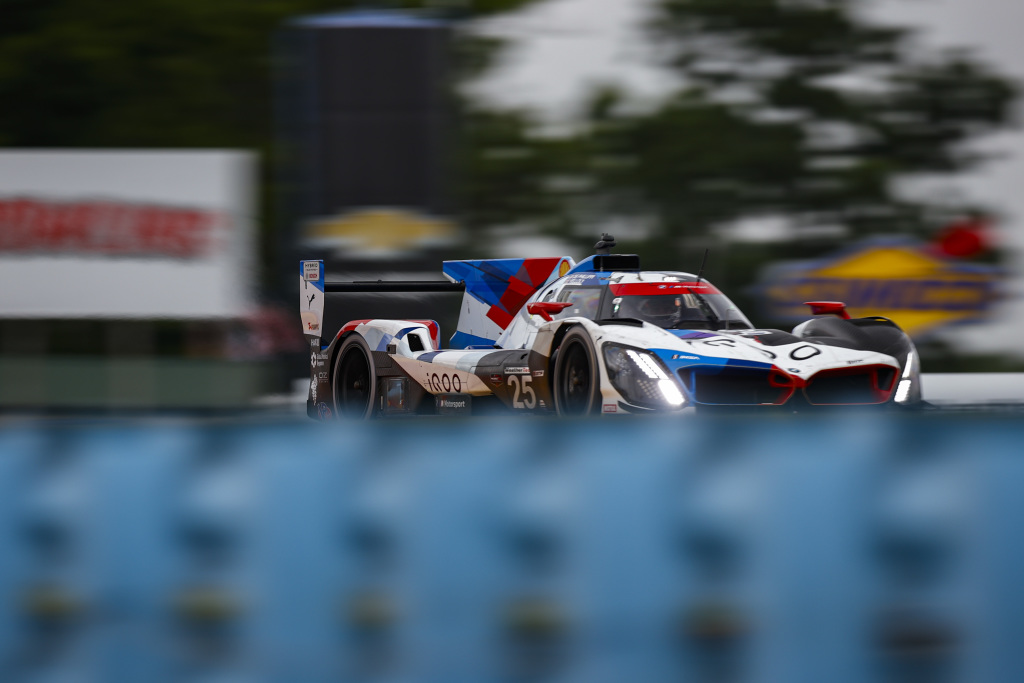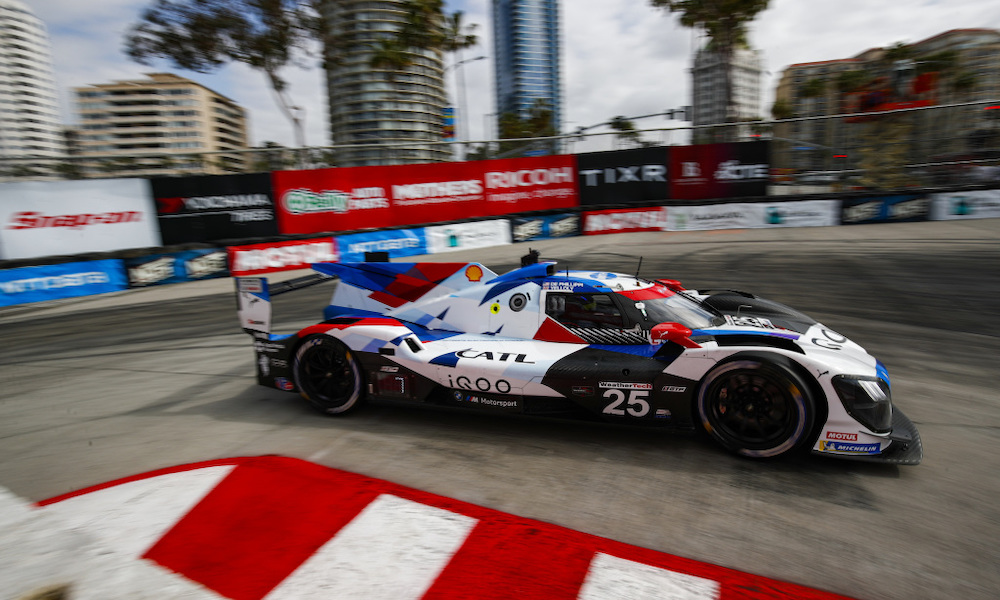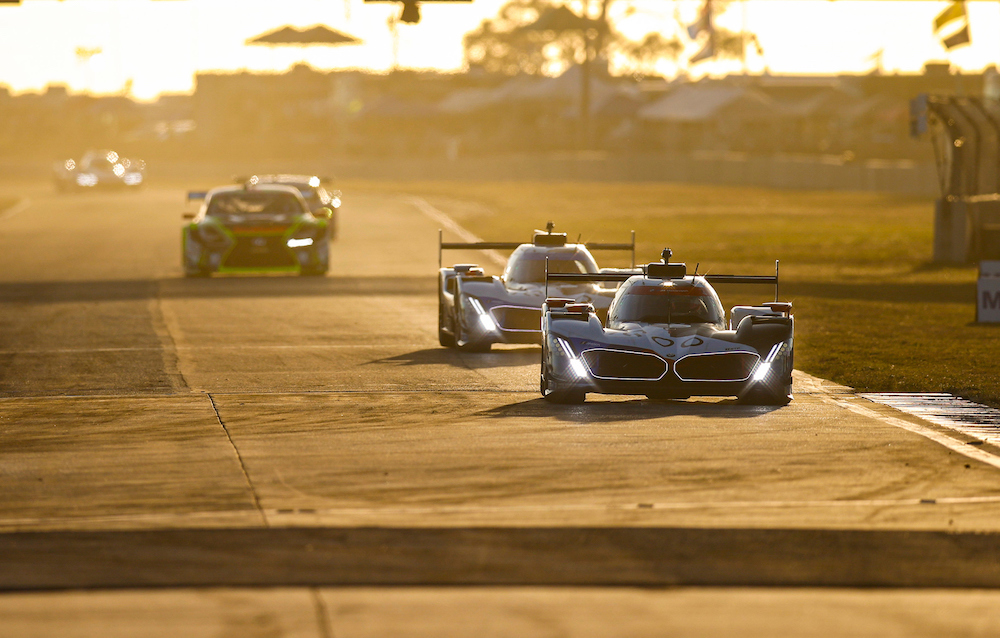Heading into IMSA’s two-day sanctioned test at the Indianapolis Motor Speedway in preparation for the upcoming TireRack.com Battle on the Bricks, discussion centered on whether the hot July test conditions would correlate to the mid-September race weekend.
Turns out that while the historical average high temperature for Sept. 17 is just under 78 degrees, Saturday’s high of 86 degrees at IMS precisely matches the average high temp from the last six years on what will be race day. The broiling conditions (Friday’s high of 91 degrees felt like triple digits with the humidity) endured this week by the 33 IMSA WeatherTech SportsCar Championship and IMSA Michelin Pilot Challenge teams that participated in the test could end up being surprisingly relevant.
The summer heat was certainly a treat for Indianapolis-based BMW M Team RLL, which saw its cars atop the timing screen at the end of Saturday’s action. Connor De Phillippi ran a series of laps in the 1m14s bracket in the No. 25 BMW M Hybrid V8, culminating in a 1m14.655s lap (117.612mph) in the final half hour of the afternoon session.
Jesse Krohn, who co-drives the No. 24 BMW in IMSA’s Michelin Endurance Cup rounds, was second fastest at 1m14.758s (117.450mph) around the 14-turn, 2.439-mile IMS road course.
“It was a productive two days and I’m really proud of the team,” said De Phillippi, who, with co-driver Nick Yelloly, ranks second in the Grand Touring Prototype (GTP) season point standings, just 10 points behind the lead No. 31 Whelen Engineering Cadillac Racing Cadillac V-Series.R duo of Alexander Sims and Pipo Derani.
“We’re trying to learn something every run, trying a lot of different software stuff and trying to improve areas of the car that I believe we can get more consistent lap times out of if we get better,” De Phillippi added. “The entire field is super tight and you’re fighting for half a tenth here, half a tenth there.”
With an eye toward the fact that the season-ending Motul Petit Le Mans at Michelin Raceway Road Atlanta is likely to be critical to deciding the championship, BMW M Team RLL was pleased to have the opportunity to get endurance drivers Krohn and Colton Herta seat time in the Nos. 24 and 25 BMWs.
“We have a bit of long run pace to find,” De Phillippi noted. “We need to try to understand that and make the car more drivable over the full stint. Now we have a direction and we can push down that path. That’s been a positive from the two days.
“Just nice to be in the mix and be competitive. Hopefully, it stays the same when we come back here in September.”
The unexpectedly quick lap times in the summer heat surprised and delighted Cadillac Racing’s Sebastien Bourdais.
The co-driver of the No. 01 Cadillac V-Series.R along with Renger van der Zande turned the fastest lap in the first of Saturday’s sessions at 1m15.025s (117.032mph). Bourdais was then third on the afternoon speed charts, improving to 1m14.809s (117.370mph).
[lawrence-auto-related count=3 category=1406]
With the GTP field closely bunched (the top five lapped within 0.181s in the morning and 0.360s in the afternoon), Bourdais was impressed that the Michelin tires kept producing quicker lap times the harder he pushed – all while showing minimal degradation.
“You think the tires have come in, and you keep going and there’s still more and more grip,” he said. “It’s very tight, and it seems like everybody is kind of driving to the potential of the tire.
“Everybody is pushing like crazy,” Bourdais added. “To get those lap times, you have to push really hard. The time doesn’t come easy; you have to really dig and use the brakes super hard. But the more you push the tires, the more it gives you. I don’t think anybody is taking it easy!”
Bourdais predicted qualifying for the race could be “deceptively quick.”
“It’s the first time we’ve had this much grip in these cars,” he said. “You have to hustle it. I don’t know what it looks like on the outside, but it’s pretty fun from the inside.”
Mikkel Jensen (No. 11 TDS Racing ORECA LMP2 07) was quickest in the Le Mans Prototype 2 (LMP2) class at 1m16.532s; Wayne Boyd (No. 17 AWA Duqueine D08, 1m20.624s) led in Le Mans Prototype 3 (LMP3). Misha Goikhberg (No. 78 Forte Racing Powered by USRT Lamborghini Huracán GT3 EVO2) topped the seven GT class entries participating in the test at 1m24.192s.
Among the 11 Michelin Pilot Challenge contenders testing at IMS, Eric Filgueiras paced the Grand Sport (GS) class in the No. 28 RS1 Porsche 718 GT4 RS Clubsport with a lap of 1m30.680s (96.828mph) in the third of four test periods, while Harry Gottsacker (No. 33 Bryan Herta Autosport with Curb Agajanian Hyundai Elantra N TCR) was fastest in Touring Car (TCR) at 1m32.388s (95.038mph) in the final session.
IMSA WeatherTech Sports Car Championship and Michelin Pilot Challenge competitors have little time to regroup before heading to Road America in Elkhart Lake, Wisconsin, site of the IMSA SportsCar Weekend, August 3-6. The IMSA SportsCar Weekend race for the WeatherTech Championship and Road America 120 for the Michelin Pilot Challenge both take place Sunday, Aug. 6.






